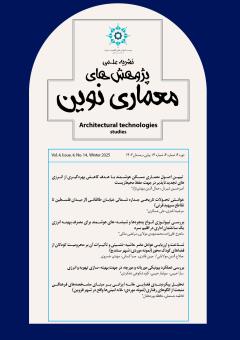شناخت و ارزیابی عوامل مضر حاشیه¬نشینی و تأثیرات آن بر محرومیت کودکان از فضاهای کودک محور (نمونه موردی: شهر سنندج)
محورهای موضوعی :
صلاح الدین مولانایی
1
,
مبین قادری
2
![]() ,
صبا کسانی
3
,
مهدی خسروی
4
,
صبا کسانی
3
,
مهدی خسروی
4
1 - دکترای تخصصی معماری سنندج. دانشگاه کردستان. دانشکده هنر و معماری. حوزه معاونت آموزشی
2 - کارشناسی ارشد معماری، دانشکده معماری، دانشگاه کردستان، کردستان، ایران.
3 - کارشناسی ارشد معماری، دانشکده معماری، دانشگاه کردستان، کردستان، ایران.
4 - کارشناسی ارشد معماری، دانشکده معماری، دانشگاه کردستان، کردستان، ایران.
کلید واژه: شهر دوستدار کودک, حاشیهنشینی, کودک, فضاهای کودک محور, محرومیت.,
چکیده مقاله :
حاشیهنشینی یکی از مسائل مهم در حیطه شهرسازی و معماری است و باید به نکات مهم تأثیرگذاری بر ساکنین و پیامدهای آن توجه ویژه داشت؛ نکاتی همچون کمبود فضاهای آمورشی و پرورشی مانند فضاهای کودک محور، مسائل امنیتی، فشارهای معیشتی و تربیتی میتواند پیامدهای بسیاری بر روی ساکنین خود بگذارد اما بزرگترین و حساسترین قربانیان آسیبهای اجتماعی کودکان هستند. در این راستا، محرومیت کودکان از فضاهای کودک محور باعث تخلیه انرژی کودکان در محیطهای نامناسب میشود که همین امر زیانهای مالی، جسمی، روحی و حتی جانی را میتواند به همراه داشته باشد. این پژوهش به شناسایی و بررسی عوامل تأثیرگذار بر شرایط نامناسب کودکان حاشیهنشین و کنکاش بر دلایل محرومیت کودکان از نبود یا کمبود فضاهای کودک محور و اثرات مخربی که بر کودکان در حال و آینده میگذارد، همچنین ارائه راهکارهایی برای بهبود این وضعیت میپردازد. پژوهش از نوع توصیفی-تحلیلی است و دادهها از طریق جمعآوری اسنادی و کتابخانهای اکتساب شدهاند، سپس با استفاده از تجارب سایر اساتید و محققین، با ذکر نمونهها و مقالات کار شده در زمینههای تخصصی متنوع، بررسی میدانی ازجمله بازدید، مصاحبه با ساکنین و پرسشنامه انجام شده است و در نهایت تحلیل و نتیجهگیری نویسندگان، صورت گرفته است. حاشیهنشینی اغلب همراه با تقابل فرهنگهای متفاوت و نامتجانس همراه است، این امر موجب بروز آسیبهایی ازجمله، افزایش جرم و جنایت و فروش مواد مخدر و کار کودکان، تهدید سلامت روانی ساکنان و بهویژه کودکان، توزیع نابرابر و نامتوازن امکانات رفاهی، بهداشتی، آموزشی و همچنین عدم کیفیت فضاهای باز شهری مانند پارک، فضای بازی کودکان است که با بررسی این عوامل در محلات (نایسر، اسلامآباد و فرجه)، کمیت و کیفیت آنها تعیینشده و به ارائه راهکار جهت رفع این عوامل پرداخته شده است.
Marginalization is one of the important issues in the field of urban planning and architecture, and special attention must be paid to the key factors and their consequences affecting residents. These factors including the lack of educational and nurturing spaces like child- oriented spaces, security issues, livelihood and educational pressures can have far-reaching effects on residents. However, the most vulnerable and sensitive victims of social harm are children. In this regard, the exclusion of children from child-oriented spaces leads to children exoanding their energy in inappropriate environments, which can cause financial, physical, mental and even fatal losses.This research aims to identify and investigate the factors influencing the unfavorable conditions of marginalized children and explore the reasons for their deprivation due to the absence or lack of child- oriented spaces and the harmful effects it has on children now and in the future. The research also proposes solutions to improve this situation. The research is descriptive-analytical in nature, and the data was gathered through document and library collection, followed by field research, including site visits, interviews with residents, and questionnaires, utilizing the experiences of other professors and researchers and referencing examples and articles from various specialized fields. Finally, the authors' analysis and conclusions have been made. Marginalization is often associated with the confrontation of different and incompatible cultures, which leads to issues such as increased crime, drug sales, child labor, threats to the mental health of residents, and especially children. There is also an unequal and unbalanced distribution of welfare, health, and educational facilitiesthe lack of quality in urban open spaces, such as parks and children's playgrounds. By examining these factors in localities (Nayser, Islamabad, Farajah), their quantity and quality were determined and solutions were proposed to aaddress these issues.
